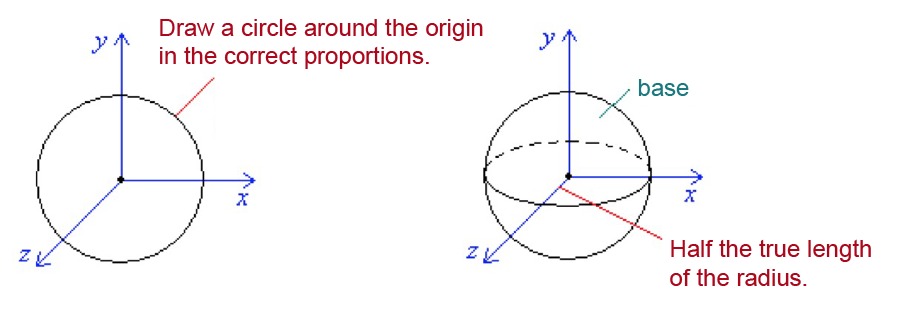12. Sphere
Sphere
Of all three-dimensional objects, the sphere has the smallest surface area relative to its volume. If the internal pressure of the object is high, a spherical shape is the most advantageous. For this reason, a free-falling drop of water chooses a spherical forms. Similarly, spherical tanks are used as pressure vessels for storing gases and liquids. Liquids that need to be kept refrigerated are often also kept in spherical containers, because insulation is cheaper when the surface area is as small as possible.
The sphere is made up of those points in space that are equidistant from a fixed point, the center of the sphere. The term "sphere" can mean either a spherical surface or a section of three-dimensional space bounded by a spherical surface.
To draw a sphere in three dimensions, proceed as follows:
When the radius of the sphere is [[$ r $]], then the volume of the sphere is [[$ V = \displaystyle\frac {4} {3} \pi r^3 $]] and the area of the sphere is [[$ A = 4 \pi r^2 $]].
The intersection pattern of a plane and a sphere is always a circle. If the plane passes through the center of the sphere, the resulting intersecton pattern is a large circle. The radius of this intersection circle is thus the same as the radius of the sphere, and the center of the circle is also the center of the sphere. Other circles that form when a plane intersects a circle are called small circles. Their radius is shorter than the radius of the sphere.
In measurements of the Earth's surface, the intersection circle is very important. The shortest route from one place to another follows the curve of the intersection circle that passes through them. Ships and planes will always endeavor to travel along the intersection circle of the Earth, as long as other conditions allow for it.
Example 1
The radius of the water balloon is [[$ 2,5 $]] cm. Calculate how many deciliters of water it contains.
[[$ \begin{align*}
V &= \displaystyle\frac {4} {3} \pi r^3 \\
\\
&= \displaystyle\frac {4} {3} \pi (2,5 \;\text{cm}) ^3 \\
\\
&= 65,449... \; \text {cm} ^3 \\
&≈ 0,065 \; \text {cm} ^3 \\
\end{align*} $]]
Answer: There are [[$ 0,65 $]] dl of water inside the water balloon.
Example 2
The circumference of a football is [[$ 71,0 $]] cm. Calculate the area of the football.
The radius of the football must first be calculated.
[[$ \begin{align*}
p &= 2 r \pi \\
r &= \displaystyle\frac {p} {2 \pi} \\
\\
r &= \displaystyle\frac {71,0 \;\text{cm}} {2 \pi} \\
\\
r &≈ 11,30 \;\text {cm}\\
\end{align*} $]]
So, the area of the football is [[$ A = 4 \pi r^2 = 4 \pi (11,30 \;\text{cm})^2 ≈ 1604 \;\text{cm}^2 $]].
Answer: The area of the football is [[$ 1604 $]] cm[[$^2$]]
Exercises
Basic exercises
Applied exercises
Challenging exercises
2/12. Submission folder for answers
Sinulla ei ole tarvittavia oikeuksia lähettää mitään.